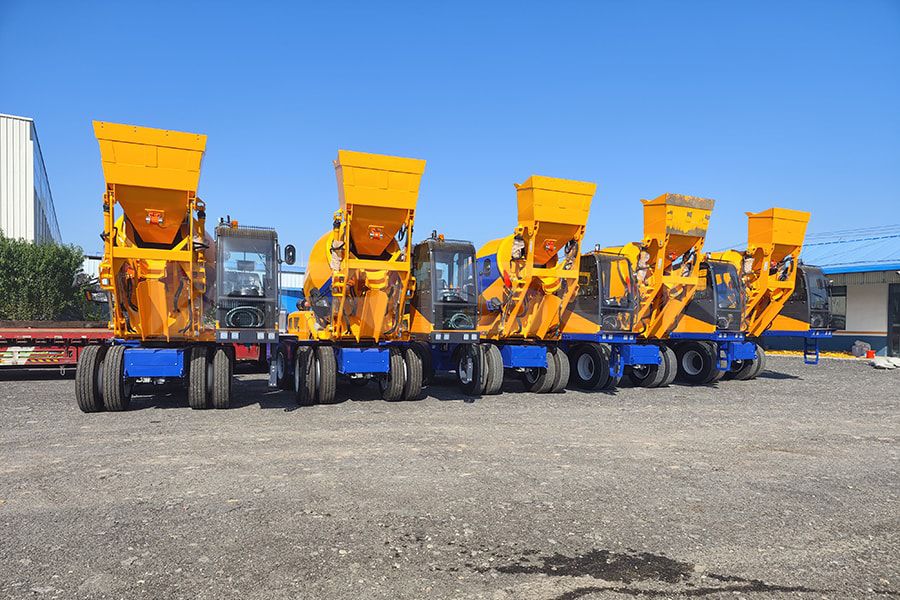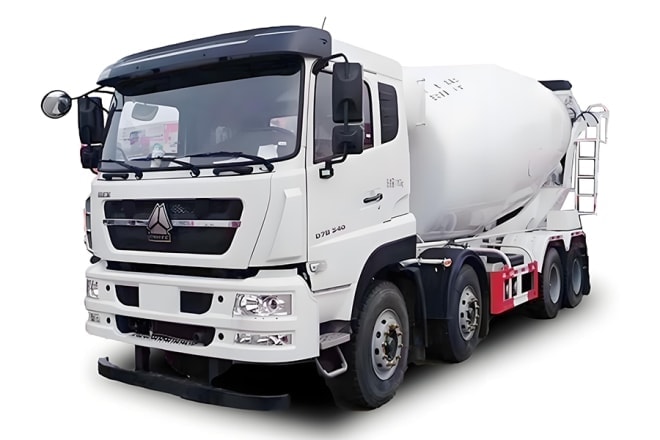
- Features & Properties
- Technical Specification
- Gallery
- Related Products
1. Multifunctional. The self-loading concrete mixer can mix cement, sand, stone and other raw materials to achieve the effect of concrete production. In addition, during the construction process, it can also be used with a concrete pump to pump concrete directly to the place where it is needed. These features make it the preferred equipment on construction sites.
2. High efficiency. The self-loading concrete mixer can automatically feed materials according to the required proportion, avoiding errors caused by manual operation and greatly improving production efficiency. At the same time, it also performs mixing to produce high-quality concrete in the shortest time, which further improves production efficiency.
3. Cost saving. The self-loading concrete mixer not only improves production efficiency, but also reduces losses caused by manual feeding. In addition, since the self-loading concrete mixer is a multi-functional equipment, it can realize multiple processes with one investment, which can also reduce the purchase and maintenance costs of some other equipment.
| Model | TSM1.2 | TSM2.0 | TSM2.5 | TSM3.5 | TSM4.0 | TSM5.5 | TSM6.5 |
| Nominal capacity |
1.0-1.2m³/batch 4-5m³/h |
1.8-2.0m³/batch 7-8m³/h |
2.4-2.6m³/batch 10m³/h |
3.5-3.8m³/batch 14-15m³/h |
3.9-4.3m³/batch 16-17m³/h |
5.2-5.6m³/batch 20-22m³/h |
6-6.5m³/batch 24-26m³/h |
| Chassis | Articulated | Articulated | Articulated | Articulated | Articulated/Rigid | Articulated/Rigid | Rigid |
| Engine brand | Yunnei/Yuchai/Cummins | Yunnei/Yuchai/Cummins | Yunnei/Yuchai/Cummins | Yuchai/Cummins | Yuchai/Cummins | Xichai/Yuchai | Weichai/Cummins |
| Engine power | 75-100HP(55-74kW) | 100-106HP(74-78kW) | 100-125HP(74-92kW) | 115-125HP(85-92kW) | 125HP(92kW) | 150HP(110kW) | 125HP(92kW) |
| Weight | 4500kg | 5700kg | 7200kg | 8300kg | 9400kg | 11200kg | 12500kg |
| Overall size | 6400x2550x3300mm | 6740x2500x 3920mm | 7560x2750x4100mm | 7830x2680x4170mm | 7710x2900x4180mm | 8450x3100x4500mm | 8450x3050x4580mm |
Note: All features, functionality and other product specifications are subject to change without notice or obligation.











 YHZ Mobile concrete plant
YHZ Mobile concrete plant
 HBT Concrete pump
HBT Concrete pump
 CM Concrete mixer truck
CM Concrete mixer truck
 LSM Vertical shaft self-loading concrete mixer
LSM Vertical shaft self-loading concrete mixer
FAQ
Q: What is the operating process of the self-loading concrete mixer?
A: 1) Entry and positioning: When the self-loading concrete mixer enters the site, it must first choose a suitable approach route to avoid conflicts with other construction equipment and pedestrians. When positioning, the mixer should be placed firmly on an open and flat site, and at the same time, it should be close to the concrete pouring position to facilitate discharging.
2) Normalized batching: First pour cement, sand, gravel, water and other ingredients into the mixer bucket according to the standard mix ratio of concrete, and set the mixing time and mixing speed, and then start the automatic mixing process.
3) Transportation and unloading: After the mixing is completed, the mixer can move to the pouring location. After arriving at the destination, the concrete can be unloaded directly or transported to the designated location through pumping pipes.
Q: What should the driver pay attention to when using a self-loading concrete mixer?
A: 1) The weight and quality of the loaded materials must comply with the rated load and configuration requirements of the self-loading concrete mixer.
2) The loading of materials must be arranged in order and the quality must be balanced, and the capacity of the mixing drum must not be exceeded.
3) When loading, a certain order must be followed, otherwise the weight of different parts of the mixing drum will be unbalanced.
4) When driving the mixer, pay attention to the speed to prevent the materials from shaking, collapsing or being thrown out of the mixing drum.
5) During transportation, you should drive according to traffic rules and ensure that there is no danger to other vehicles and pedestrians.
6) When unloading, you must find a flat ground. Do not unload on slopes or uneven ground to avoid causing vehicle tilt or concrete loss.
Q: Why is my self-loading concrete mixer becoming less and less efficient? How should I maintain or repair it?
A: Some customers have asked us why its working efficiency is getting lower and lower. The reason for this may be that there is no timely maintenance and repair, or it may be that there is no correct maintenance. I believe the proportion of the second one should be high, so what are the specific maintenance taboos for it?
1. Add engine oil but don't change it.
2. Casual installation of cylinder liners and pistons.
3. No check of plunger stroke allowance.
Q: What are the key components and maintenance points of a self-loading concrete mixer?
A: 1) Hydraulic drive system: The hydraulic system is the core system of the self-loading concrete mixer. In order to ensure that the mixer can operate normally, the hydraulic oil level of the oil circuit radiator and reducer must be checked before each start to ensure that the oil level indication is within the range of the viewing window. At the same time, its cleanliness must be ensured to prevent dust particles and moisture from contaminating the system's hydraulic oil and causing the system to not work properly or be damaged.
2) Water supply system: The amount of water added in the water supply system is generally three-quarters of the water tank; When the mixer is driving, all valves in the water system should be closed to avoid affecting the braking performance or burning the friction plates, thereby affecting the mixer's braking performance. It is prohibited to weld or modify the water tank at will, and avoid impact with heavy objects; The valve should be checked frequently to see if it is clogged or working abnormally; When used in an environment where freezing is possible, the water supply system must be drained to prevent the pipes from freezing and cracking; The sealing should be checked frequently. After disassembly and repair, thread sealant should be applied to key parts.
3) Mixing drum: After 50 hours of first use, check whether the bolts on the drum and other parts are loose. The lubrication of the rollers and raceway should be checked every day before starting the mixer. Open the roller guard once a month, clean the oil stains and add lubricating grease.


